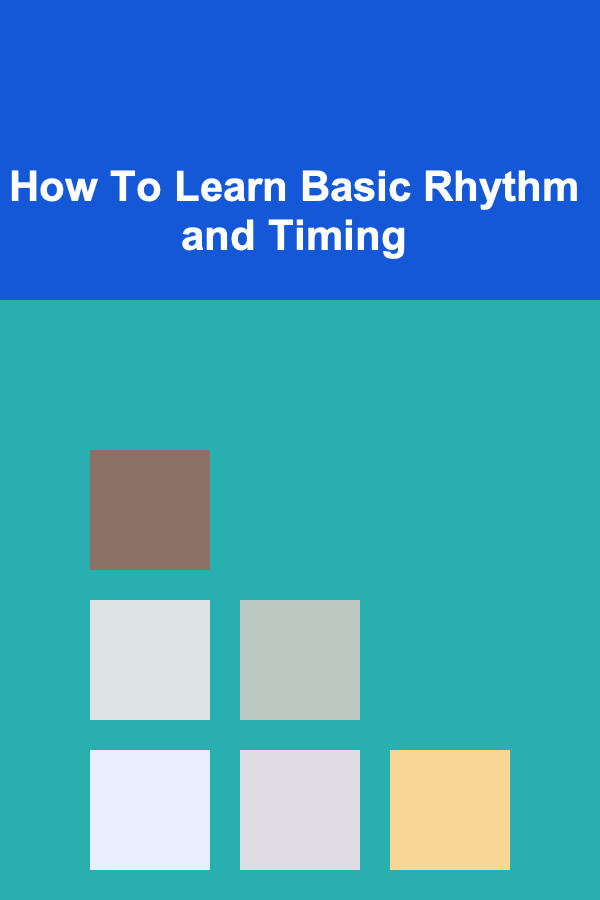
How To Learn Basic Rhythm and Timing
ebook include PDF & Audio bundle (Micro Guide)
$12.99$6.99
Limited Time Offer! Order within the next:

Rhythm and timing are the foundation of all music. Whether you're a beginner, an intermediate player, or even a seasoned musician, understanding rhythm is vital for developing musicality and precision. Rhythmic skills not only help you stay in time but also shape the overall feel and groove of a piece. Learning basic rhythm and timing is essential for anyone interested in improving their musical abilities, whether they play an instrument, sing, or compose music.
In this article, we will explore the importance of rhythm, how to develop it, and the essential skills you need to cultivate in order to improve your timing and rhythmic accuracy. From basic concepts to advanced techniques, this guide will provide you with the tools and insights necessary to master rhythm.
The Importance of Rhythm and Timing
Before diving into how to learn rhythm, let's first understand why rhythm and timing are so important in music.
1. The Backbone of Music
Rhythm is the heartbeat of music. Without it, music would be a disorganized sequence of sounds with no structure. It serves as the organizational framework around which melody and harmony are placed. Every song, from rock to classical, depends on rhythm to keep the music flowing and cohesive.
2. Facilitates Communication in Ensemble Playing
Whether you're playing in a band, orchestra, or solo, rhythm is key to playing in sync with other musicians. Timing ensures that everyone is on the same page, so that the group moves together and creates a cohesive musical performance. A slight deviation in timing can disrupt the entire ensemble, which is why developing solid rhythmic skills is crucial for ensemble playing.
3. Sets the Mood and Groove
Rhythm also plays a significant role in setting the mood of a piece. The type of rhythm used can create tension, excitement, calmness, or any other emotional response. A fast tempo with syncopated rhythms may create an upbeat, energetic feeling, while slow, sustained rhythms can create a more relaxed, emotional atmosphere.
4. Improves Musicianship
Developing rhythm and timing is an essential aspect of becoming a proficient musician. It not only helps you stay in time but also improves your overall musicianship by encouraging a better sense of musical structure. This will make your playing more precise and expressive, whether you're performing, improvising, or composing music.
Getting Started with Basic Rhythm Concepts
1. Understanding the Basics of Beats and Tempo
At its core, rhythm consists of beats. A beat is the basic unit of time in music and represents a regular, repeating pulse. Beats are grouped into measures, which are separated by bar lines. The number of beats in a measure depends on the time signature, which we'll discuss in the next section.
Tempo refers to the speed at which the beats occur. It is typically measured in beats per minute (BPM). For example, if a song is at a tempo of 120 BPM, that means there are 120 beats in one minute. Understanding the tempo helps musicians play at the right speed, whether it's slow and relaxed or fast and energetic.
2. Time Signatures: The Structure of Rhythmic Organization
Time signatures indicate how many beats are in each measure and what type of note gets the beat. The most common time signature is 4/4, meaning there are four beats in a measure, and each beat is represented by a quarter note. Other common time signatures include 3/4 (three beats per measure, with each beat as a quarter note) and 6/8 (six beats per measure, with each beat as an eighth note).
The time signature provides the framework for understanding where the beats fall within a measure. It's crucial to understand how the time signature works, as it will guide you in counting and feeling the rhythm correctly.
3. Subdividing Beats
Subdividing a beat means breaking down each beat into smaller units to create more complex rhythms. For example, in 4/4 time, each beat can be divided into two eighth notes or four sixteenth notes. The ability to subdivide beats allows for greater flexibility in rhythm and helps musicians play more intricate rhythms with precision.
The most common subdivisions are:
- Quarter Notes (1 beat): The basic unit of time in 4/4 time.
- Eighth Notes (1/2 beat): Subdivide each quarter note into two smaller notes.
- Sixteenth Notes (1/4 beat): Subdivide each quarter note into four smaller notes.
- Dotted Notes: A note with a dot after it extends its duration by half of its original value.
4. Understanding Strong and Weak Beats
In most time signatures, certain beats are naturally emphasized or accented. In 4/4 time, for example, the first beat of each measure is typically the strongest or most emphasized. This is called the downbeat. The second and fourth beats are weaker and less emphasized, while the third beat is considered moderately strong.
Understanding where the strong and weak beats lie in a measure is essential for playing with proper emphasis and creating the right musical feel. Musicians often accentuate the downbeat to give the rhythm a clear and structured foundation.
Developing Basic Rhythm Skills
Now that we've established the basic concepts of rhythm, let's explore some practical methods to develop your rhythmic skills.
1. Clapping and Tapping Exercises
One of the simplest ways to practice rhythm is through clapping or tapping. Start by clapping along to a metronome set to a slow tempo. Focus on keeping your claps consistent with the beat. Once you're comfortable, try tapping out more complex rhythms, including eighth notes, sixteenth notes, and dotted notes.
As you progress, challenge yourself to clap in sync with the downbeats and offbeats, which are essential for understanding more intricate rhythms. Try tapping along with songs and counting the beats aloud to improve your timing and internal pulse.
2. Using a Metronome
A metronome is an invaluable tool for practicing timing. It provides a consistent pulse that helps you stay in time. Start by setting the metronome to a slow tempo (around 60 BPM) and practice playing simple rhythms along with it. Gradually increase the tempo as you become more comfortable, and challenge yourself with faster speeds or more complex rhythms.
Many digital metronomes have various time signature settings, which allow you to practice rhythms in different meters. This is an excellent way to improve your ability to play in time and develop a solid sense of rhythmic accuracy.
3. Counting Out Loud
When you're practicing rhythms, it's essential to count out loud to internalize the timing. Start by counting the beats of each measure: "1, 2, 3, 4" in 4/4 time. For more complex rhythms, break down the subdivisions and count them as well, such as "1 and 2 and 3 and 4 and" for eighth notes or "1 e and a 2 e and a" for sixteenth notes.
Counting out loud forces you to think about the timing and ensures you're staying on track. It also reinforces the connection between what you're playing and the underlying rhythm.
4. Practice with a Drum or Percussion Instrument
Drums and percussion instruments are an excellent way to practice rhythm because they allow you to focus entirely on the timing and coordination required for rhythmic precision. If you have access to a drum set or a practice pad, use it to play along with a metronome or backing track.
You can start by practicing basic drum beats or simple hand percussion patterns. Once you become comfortable with the basics, try incorporating more advanced rhythms such as syncopation and polyrhythms. Playing along with other musicians or backing tracks can further improve your timing and rhythmic feel.
5. Listening to Music with Strong Rhythmic Elements
Listening to music with strong rhythmic patterns is a great way to develop your sense of timing. Pay close attention to how the rhythm section (drums, bass, percussion) interacts with the rest of the music. Try tapping your foot or clapping along with the beat. Focus on identifying the time signature, subdivisions, and accents in the music.
If you're just starting, focus on music with simple, steady rhythms like rock or pop. As you improve, explore more complex genres such as jazz, funk, or classical music, where rhythms can be more intricate.
6. Playing Along with Backing Tracks
Another great way to develop your rhythmic skills is to play along with backing tracks or play-along videos. These tracks allow you to practice your timing in a musical context, simulating the experience of playing in a band or ensemble. By playing along, you'll get a better feel for staying in time with other musicians and develop a stronger sense of rhythm.
Many play-along tracks are available online or through music apps. Start with simpler tracks and gradually progress to more complex ones as your rhythmic skills improve.
Advanced Techniques for Improving Rhythm
As you develop your basic rhythmic skills, you can begin exploring more advanced techniques to further enhance your timing and rhythm.
1. Syncopation
Syncopation refers to the placement of accents or notes on weak beats or offbeats. It creates a sense of tension and rhythmic interest in music. To practice syncopation, try playing rhythms where the accents fall on unexpected parts of the measure, such as the "and" of the beat or between the beats.
2. Polyrhythms
Polyrhythms involve playing two or more contrasting rhythms simultaneously. For example, you might play a 3 against 4 rhythm, where one part plays in groups of three notes per beat and another part plays in groups of four. Polyrhythms are often used in more complex music genres like jazz and classical.
To practice polyrhythms, start slowly and focus on keeping both rhythms clear and in time. It may take time to coordinate both parts, but with regular practice, you'll develop the ability to play intricate rhythmic patterns.
3. Swing Feel
The swing feel, commonly used in jazz and blues, involves playing eighth notes in a "long-short" pattern, where the first eighth note of a pair is longer than the second. To practice the swing feel, play along with swing-style music and focus on getting the "feel" of the rhythm rather than counting the exact subdivisions.
4. Complex Time Signatures
As you become more comfortable with basic time signatures, you can start exploring more complex time signatures like 5/4, 7/8, or 11/8. These time signatures create unique rhythmic challenges because they don't divide neatly into equal groups of two or three. Practice counting and subdividing the beats to stay in time with these complex time signatures.
Conclusion
Mastering rhythm and timing is an ongoing process that requires patience, practice, and attention to detail. By understanding the basics of beats, tempo, and time signatures, and by engaging in regular practice, you can develop a strong sense of rhythm that will improve all aspects of your musicianship.
Whether you're a beginner or an experienced player, remember that rhythm is an essential skill that forms the foundation of all music. With consistent effort and dedication, you can build a solid rhythmic foundation that will enhance your playing, creativity, and overall musical expression.

How to Add a Home Gym to Your Renovation Plans
Read More
How to Declutter Your Closet in Just One Weekend
Read More
How to Set Your Rates for Data Entry or Text Conversion Projects
Read More
How to Stage Your Home's Bathrooms to Impress Buyers
Read More
How To Explore Quantum Computing for Manufacturing Optimization
Read More
How To Deal with Excessive Barking: A Comprehensive Guide
Read MoreOther Products

How to Add a Home Gym to Your Renovation Plans
Read More
How to Declutter Your Closet in Just One Weekend
Read More
How to Set Your Rates for Data Entry or Text Conversion Projects
Read More
How to Stage Your Home's Bathrooms to Impress Buyers
Read More
How To Explore Quantum Computing for Manufacturing Optimization
Read More